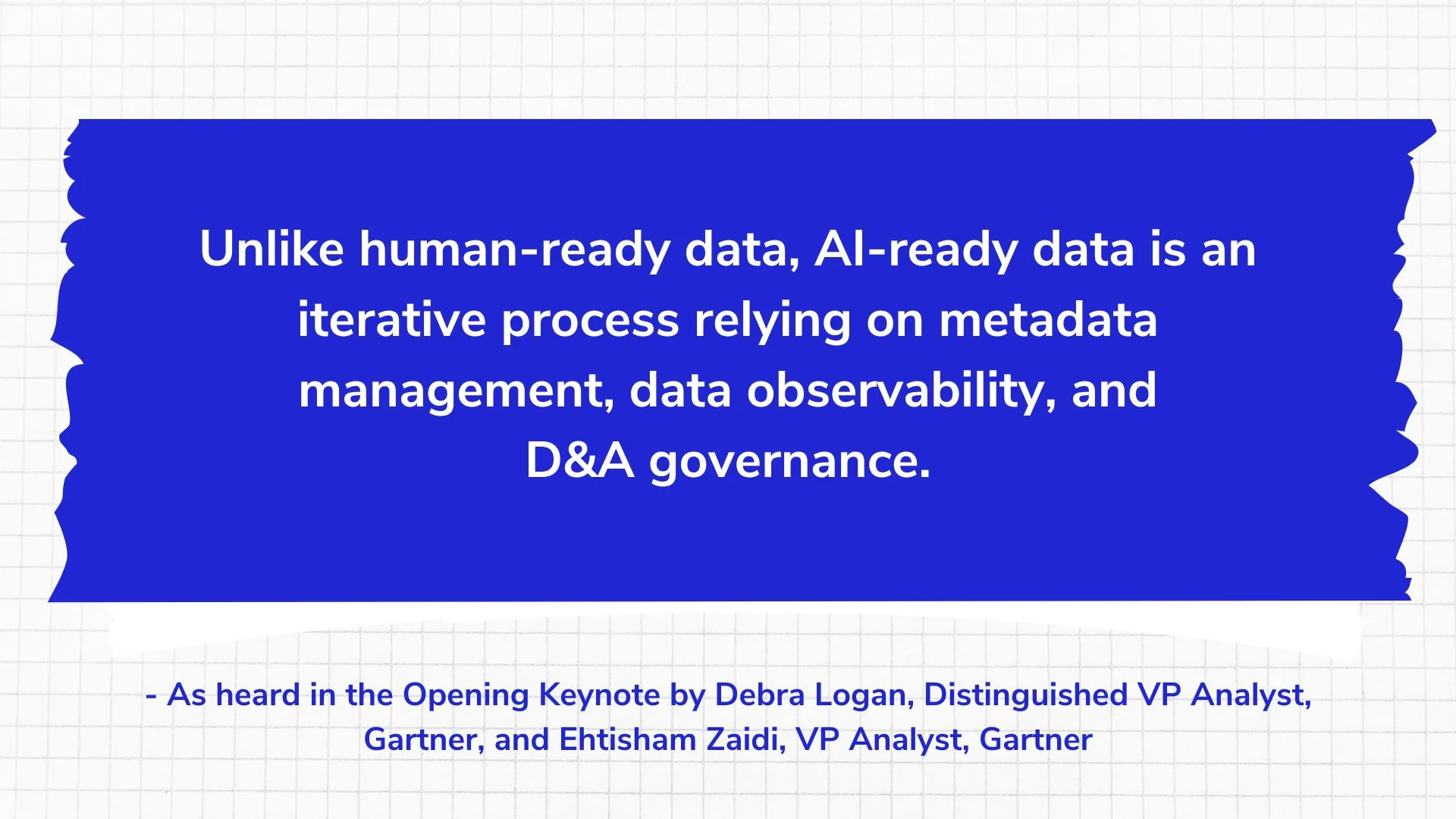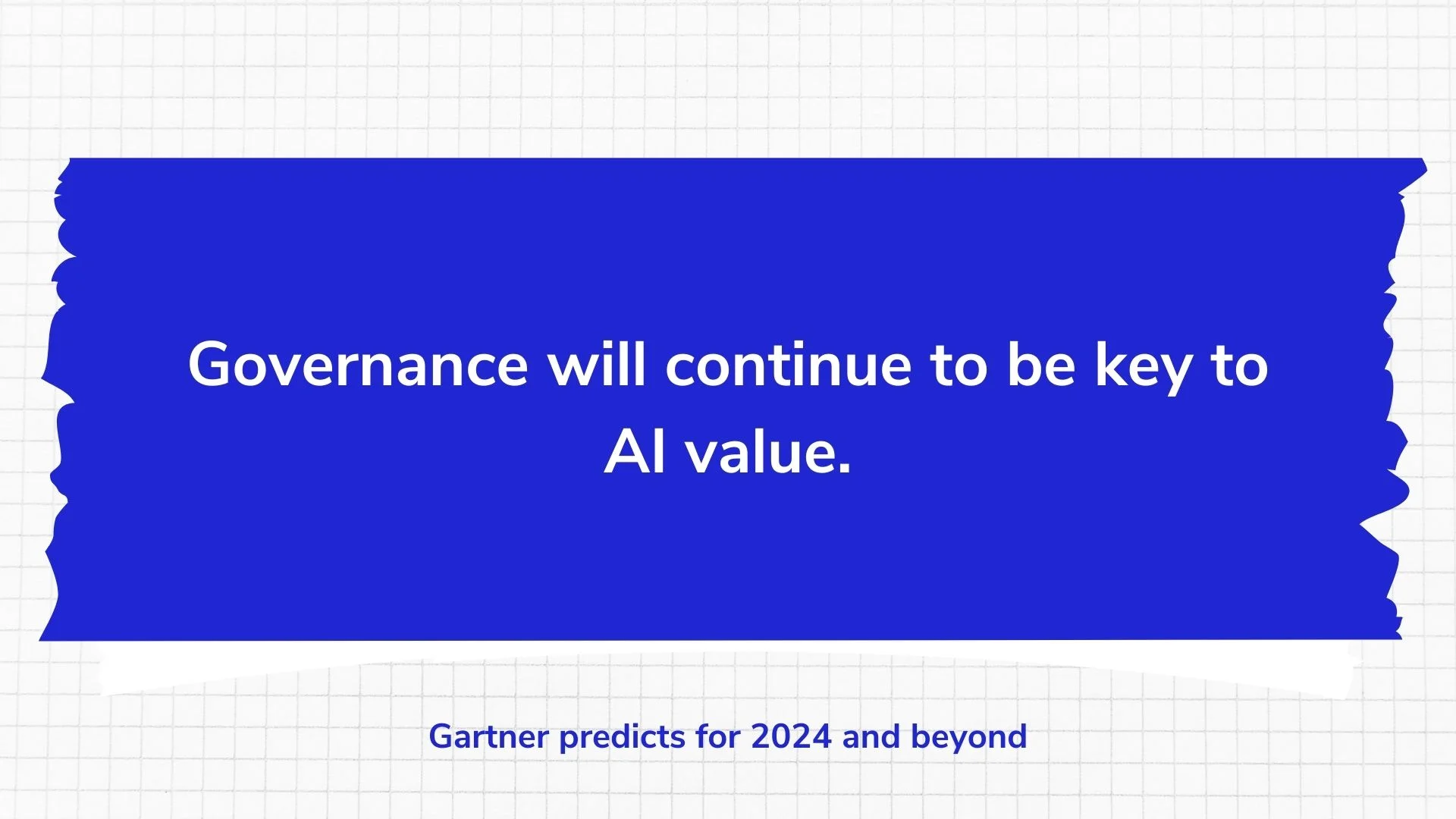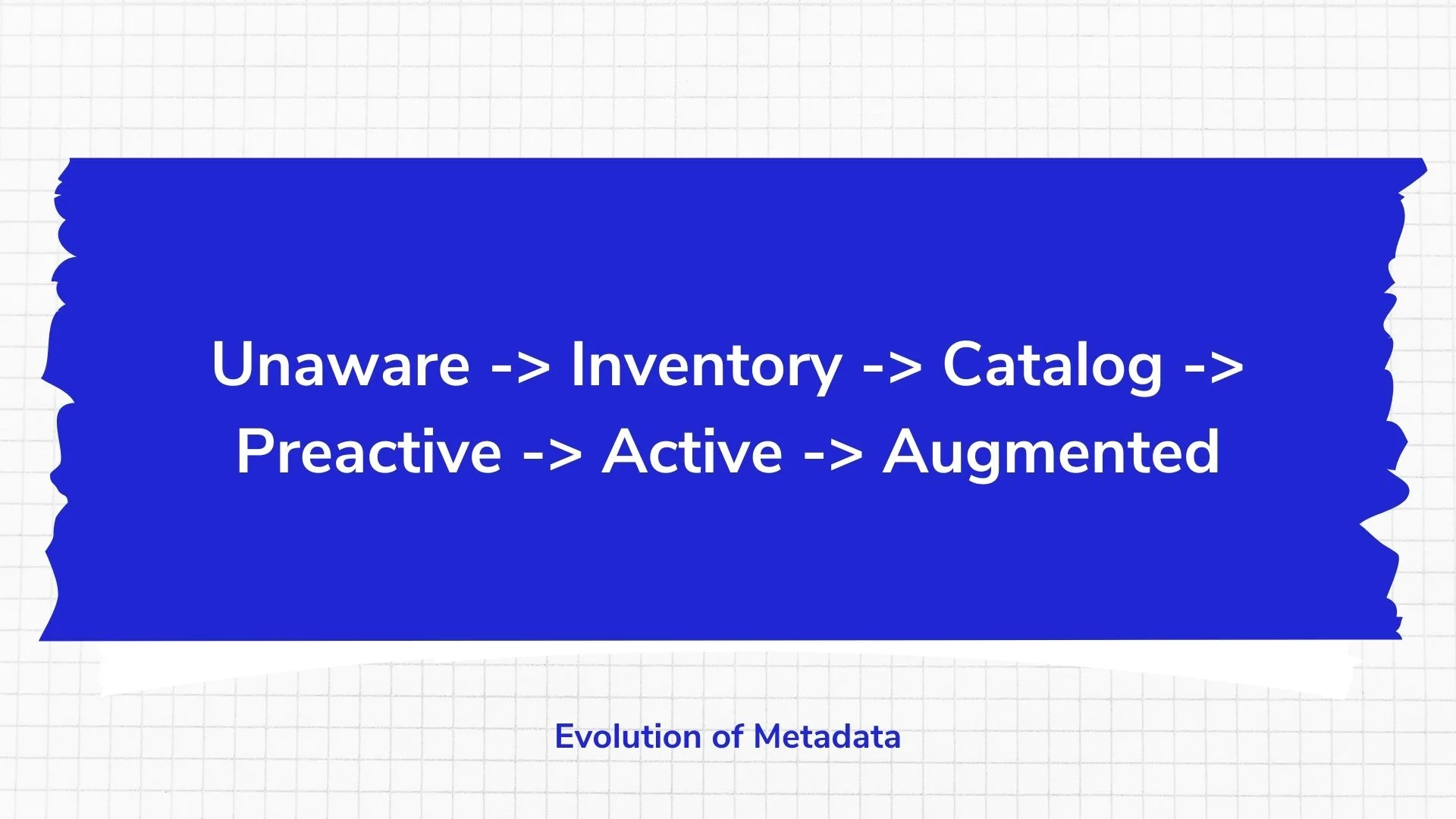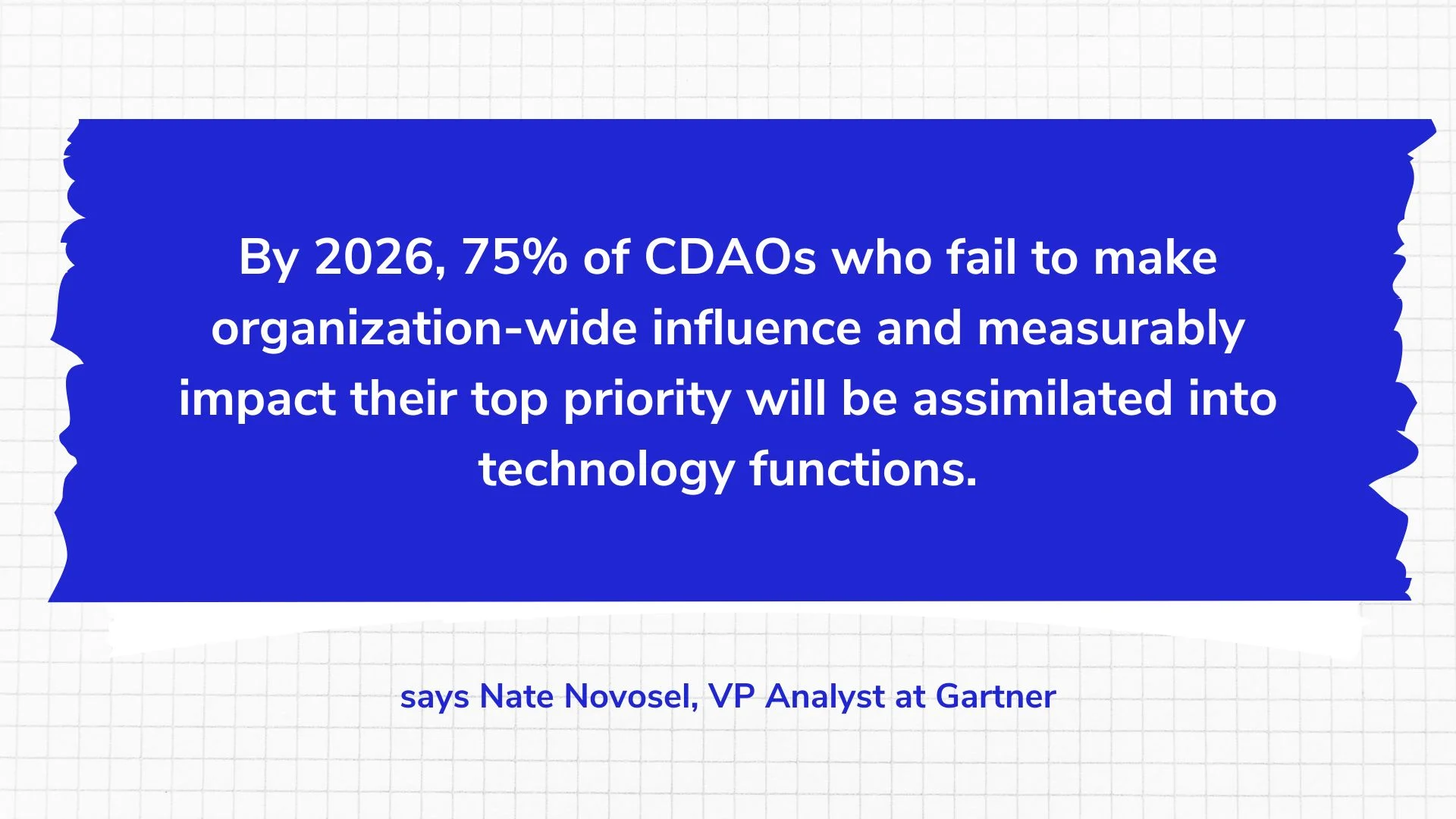5 Top Takeaways from Gartner Data & Analytics Summit 2024
Share this article
We see the Gartner Data and Analytics Summit as a barometer for the data universe. This year’s summit in Orlando was no exception. The best and brightest experts, analysts, practitioners, and service providers from the world of data and analytics gathered to discuss what is (and should be) top of mind.
Unsurprisingly, our team hasn’t stopped talking about everything they’ve learned from the Summit. As more of them shared their highlights, we couldn’t help but notice some common themes.
If you couldn’t make it to the summit or missed out on a few sessions (perhaps you were caught up with some tempting ice cream at the Atlan truck – yes, we saw you!), rest assured, we’ve got you covered.

5 top takeaways from Gartner Data & Analytics Summit 2024 #
- GenAI stands on the foundation of metadata maturity
- Modern data governance starts from desired outcomes, rather than data issues
- Active metadata will become the LLM prompt engine
- Data leadership must own and drive business outcomes
- Approaching business strategy through the lens of data and analytics will improve decisions and performance
Gartner’s Inaugural Magic Quadrant for D&A Governance is Here #
In a post-ChatGPT world where AI is reshaping businesses, data governance has become a cornerstone of success. The inaugural report provides a detailed evaluation of top platforms and the key trends shaping data and AI governance.
Read the Magic Quadrant for D&A Governance
Table of contents #
- GenAI stands on the foundation of metadata maturity
- Modern data governance starts from desired outcomes, rather than data issues
- Active metadata will become the LLM prompt engine
- Data leadership must own and drive business outcomes
- Approaching business strategy through the lens of data and analytics will improve decisions and performance
- Related reads
GenAI stands on the foundation of metadata maturity #

GenAI (generative AI) is at an inflection point for data and analytics. Naturally, it got a separate track at the summit and was also the focus of the opening keynote.
The clear message was that before diving into ambitious GenAI projects and exploring use cases for your organization, ensure your data’s AI-readiness. The most straightforward route to achieving AI-ready data is investing in metadata management maturity to track source lineage, reduce bias, and provide trust. Data observability is also necessary for qualifying usage and operationalizing models.
In AI-related discussions, themes such as data governance, scaling AI in the enterprise, and de-risking AI strategies stood out. Arun Chandrasekaran, Distinguished VP Analyst, Gartner, in his session 10 Best Practices for Scaling Generative AI Across the Enterprise, highlighted three essential aspects:
- Evaluating AI use cases: Identify AI initiatives by their potential value and feasibility. For those with high priority, determine whether to buy applications, embed through APIs, extend with reusable components, customize via fine-tuning, or develop custom models.
- Laying the foundation for effective AI: The performance of AI technologies is fundamentally tied to the quality of the underlying data and the data and AI literacy of its users.
- Enhancing value with organizational data: GenAI offers the most significant value when paired with your organization’s data, highlighting the importance of investing in metadata capture and management.
Also, read → Is your data AI-ready? Here’s what you need to know.
Modern data governance starts from desired outcomes, rather than data issues #

Modern data governance transcends traditional focus on data issues, orienting itself towards achieving desired business outcomes such as generating value from GenAI. In his session ‘Data and Analytics Governance: Foundations and Future,’ Guido De Simoni, VP Analyst, Gartner, explores the fundamental principles of this governance framework.
Top highlights include:
Align governance with business objectives
Data governance isn’t merely about establishing rules; it’s about specifying decision rights and creating an accountability framework to encourage appropriate behavior. The crux of effective governance lies in aligning these decision rights with an organization’s decision-making processes. This alignment ensures that governance processes support and enhance business objectives rather than acting as bottlenecks.
Recognize the hierarchy of data
Not all information holds the same value to an organization. A strategic approach involves adopting an enterprise-wide model encompassing all key Data & Analytics (D&A) artifacts. Within this model, defining and measuring trust at varying levels is crucial. This distinction allows for more nuanced governance that acknowledges the differential impact and importance of diverse data types and sources.
Embrace contextual governance amidst disruption
The notion of “disruption-as-usual” has become a staple in today’s business environment. However, rather than viewing disruption as a hurdle, modern governance models embrace it, building practices that are contextual, led by business needs, and grounded in trust. This approach ensures that governance is flexible, adaptive to change, and deeply integrated with the strategic direction and priorities of the business.
Dive deeper → Creating a data governance strategy mapped to outcomes
Active metadata will become the LLM prompt engine #
Metadata is not just an adjunct to data; it is data in its own right, forming the underlying structure of how data is interconnected. Every interaction with data generates metadata, laying the groundwork for sophisticated analytics and AI applications. This makes active metadata—a dynamic, ever-evolving layer of data about data—crucial for understanding the “physics” of data and its lifecycle from creation to utilization.
Mark Beyer, Distinguished VP Analyst, Gartner, advises Data & Analytics (D&A) leaders to look at the following elements for more effective LLM deployments:
- Understand the evolution of metadata: As organizations evolve from being unaware to fully leveraging augmented metadata, they unlock its strategic value. This journey transforms metadata from static to dynamic, enabling deep insights and operational intelligence.

- Focus on lineage: Understanding the data asset’s lineage, enriched by annotations and process metadata analysis, is vital. This provides critical context and insights into data transformations, enhancing data’s value and utility.
- Add context and responsiveness: Active metadata is set to revolutionize Large Language Models (LLMs) by acting as a prompt engine. It can orchestrate model training, prompt management, and utilization, making LLMs more responsive and context-aware.
Active metadata’s role in LLM deployment underscores a strategic pivot towards more intelligent, integrated data and AI practices, fostering a culture of innovation and enhanced decision-making.
Dive deeper → What is active metadata? Your 101 guide
Data leadership must own and drive business outcomes #

CDAOs must rapidly reinvent themselves to take charge as drivers of business innovation and outcomes. Sarah James, Sr Director Analyst at Gartner, goes as far as to say, “Our job is to push the organization to think differently (or to think at all). If we’re not doing that, then we’re not acting as change agents, we’re acting as order takers.”
Some recommendations for data leadership at the Gartner Summit include:
- Cultivate influence: Strengthen your network and reputation to ensure you have the authority and resources needed for your duties. Assess if your role permits the fulfillment of these responsibilities.
- Showcase value: Navigate through complexities by consistently demonstrating the business value of your work. Use past successes as justification for more resources and an expanded budget.
- Lead change initiatives: Form a change leadership team to exemplify your vision and foster connections with key executives and influencers through genuine empathy and shared goals.
- Narrate data-driven successes: Build stories around data-driven changes that highlight benefits at both organizational and individual levels, underlining the reasons behind key performance indicators (KPIs).
Download → The secrets of a modern data leader
Approaching business strategy through the lens of data and analytics will improve decisions and performance #
Placing data and analytics (D&A) at the heart of business strategy transforms outcomes and fosters a cultural shift toward data-driven decision-making. According to Gartner, the defining elements of data strategy include:
- Ensuring responsiveness: A dynamic strategy adapts to external and internal changes, thereby aligning with stakeholder expectations and business goals. It leverages D&A to navigate societal, business, and technological shifts, maintaining relevance and competitiveness.
- Embracing stakeholder-centric value: The strategy articulates a clear value proposition, demonstrating how D&A directly contributes to achieving strategic business outcomes. It emphasizes the importance of setting specific goals and metrics that resonate with key stakeholders, ensuring their needs and expectations are met.
- Operationalizing D&A: Success in D&A requires more than insight; it demands action. Establishing a dedicated change team to promote a data-centric culture, developing compelling data-driven stories, and addressing resistance to change is pivotal. This approach encourages the organization to embrace D&A fully.
- Fostering decision-centric D&A: Adopting a decision-centric approach enhances business impact, making decisions more informed, continuous, and connected. This involves integrating decision intelligence practices and roles, such as decision engineers, into D&A processes.
This strategy positions D&A not just as a support function but as a critical driver of business success, fostering a future where data and analytics empower decisions.
We hope you’ve received more than just a glimpse of what unfolded at the Summit. The discussions covered a range of topics, such as the fundamentals of GenAI, a modern approach to data governance, the evolving necessity for CDAOs to reinvent themselves, and the integration of D&A into business strategy.
Following up on this blog, we’re organizing a webinar titled Key Takeaways from the Gartner Data and Analytics Summit 2024, hosted by Austin Kronz, Director of Data Strategy at Atlan (and former Gartner Analyst). If you’re interested in diving deeper and joining the discussion, sign up here.
Gartner D&A Summit 2024: Related reads #
- Gartner Data & Analytics Summit 2024: What to Expect
- 6 Must-Attend Gartner Conferences in 2024 for D&A Practitioners
- Gartner Data Catalog Research Guide
- Gartner Active Metadata Management
- Gartner on Data Mesh
- Gartner on Data Fabric
- Gartner on Data Lineage
- Gartner on DataOps
- Gartner Magic Quadrant for Metadata Management
- Gartner Magic Quadrant for Data Quality
Share this article











